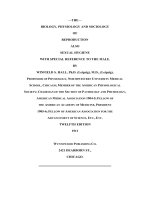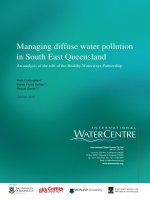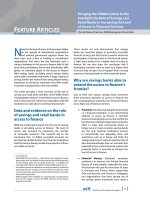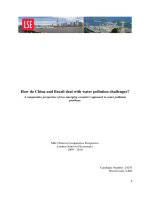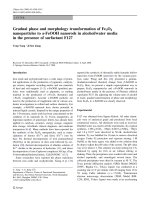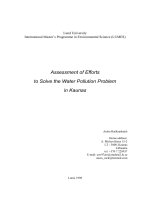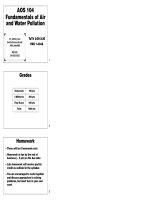RESPONSES OF ORGANISMS TO WATER STRESS docx
Bạn đang xem bản rút gọn của tài liệu. Xem và tải ngay bản đầy đủ của tài liệu tại đây (6.89 MB, 188 trang )
RESPONSES OF
ORGANISMS TO WATER
STRESS
Edited by Şener Akıncı
Responses of Organisms to Water Stress
/>Edited by Şener Akıncı
Contributors
Hamadeh, Allan Lobato, Elaine Guedes, Cândido Oliveira Neto, Douglas Marques, Roberto Costa, Joaquim Siveira,
Elizamar Ciríaco Da Silva, Manoel Albuquerque, André Azevedo Neto, Carlos Silva Junior, Alexandre Bosco de Bosco
De Oliveira, Nara Lídia Mendes Alencar, Enéas Gomes-Filho, Masaharu Motoshita, Sonia Marli Zingaretti, Marielle
Cascaes Inacio, Livia De Matos Pereira, Suzelei De Castro França, Tiago Antunes Paz
Published by InTech
Janeza Trdine 9, 51000 Rijeka, Croatia
Copyright © 2013 InTech
All chapters are Open Access distributed under the Creative Commons Attribution 3.0 license, which allows users to
download, copy and build upon published articles even for commercial purposes, as long as the author and publisher
are properly credited, which ensures maximum dissemination and a wider impact of our publications. After this work
has been published by InTech, authors have the right to republish it, in whole or part, in any publication of which they
are the author, and to make other personal use of the work. Any republication, referencing or personal use of the
work must explicitly identify the original source.
Notice
Statements and opinions expressed in the chapters are these of the individual contributors and not necessarily those
of the editors or publisher. No responsibility is accepted for the accuracy of information contained in the published
chapters. The publisher assumes no responsibility for any damage or injury to persons or property arising out of the
use of any materials, instructions, methods or ideas contained in the book.
Publishing Process Manager Iva Lipovic
Technical Editor InTech DTP team
Cover InTech Design team
First published January, 2013
Printed in Croatia
A free online edition of this book is available at www.intechopen.com
Additional hard copies can be obtained from
Responses of Organisms to Water Stress, Edited by Şener Akıncı
p. cm.
ISBN 978-953-51-0933-4
free online editions of InTech
Books and Journals can be found at
www.intechopen.com
Contents
Preface VII
Chapter 1 Quantification of Stress Arisen from Freshwater Consumption
in the Context of Life Cycle Assessment 1
Masaharu Motoshita
Chapter 2 Drought and Its Consequences to Plants – From Individual to
Ecosystem 17
Elizamar Ciríaco da Silva, Manoel Bandeira de Albuquerque, André
Dias de Azevedo Neto and Carlos Dias da Silva Junior
Chapter 3 Tolerance to Drought in Leguminous Plants Mediated by
Rhizobium and Bradyrhizobium 49
Allan Klynger da Silva Lobato, Joaquim Albenísio Gomes da Silveira,
Roberto Cezar Lobo da Costa and Cândido Ferreira de Oliveira Neto
Chapter 4 Comparison Between the Water and Salt Stress Effects on Plant
Growth and Development 67
Alexandre Bosco de Oliveira, Nara Lídia Mendes Alencar and Enéas
Gomes-Filho
Chapter 5 Silicon: A Benefic Element to Improve Tolerance in Plants
Exposed to Water Deficiency 95
Allan Klynger da Silva Lobato, Elaine Maria Silva Guedes, Douglas
José Marques and Cândido Ferreira de Oliveira Neto
Chapter 6 Water Stress in Small Ruminants 115
Lina Jaber, Mabelle Chedid and Shadi Hamadeh
Chapter 7 Water Stress and Agriculture 151
Sonia Marli Zingaretti, Marielle Cascaes Inácio, Lívia de Matos
Pereira, Tiago Antunes Paz and Suzelei de Castro França
Preface
Water is a fundamental requirement for life and an essential factor for all organisms, from
cells to whole body, and from first cell division until death. Globally only 2.5% of water is
present as fresh water, of which about 68% is in glaciers and 30% in ground water. The rest
is to be found as atmospheric humidity, surface water in the form of rivers and lakes, soil
moisture, and in plants and animals. Water has a crucial role as a permanent substance of
the central vacuole in plant cells, with the water component ranging from 85-95% in fresh
leaves and young tissues, 35-75% in woody parts and stems, and 5-15% in dry seeds.
Water stress is one of the major environmental factors that affects most terrestrial organisms,
and in plants leads to readily distinguishable effects on growth parameters, accompanied by
changes in biomass ratios and physiological and biochemical alterations. Stress symptoms
are visible morphologically and as biomass reduction depending on the severity and
duration of drought exposure. Water stress (drought) decreases plant water potential and
turgor, causing physiological difficulties, inhibition of photosynthesis and respiration,
effects on metabolic and biochemical processes, changes in carbohydrate content, quantity
and quality of nutrients, translocation, lipid composition in leaves, and plant hormone
regulation.
Water stress not only effects plant-animal community interactions but also human societies,
as a result of impacts on horticultural systems and agricultural lands, as well as natural
ecosystems. Every year many cultivated areas of the world experience drought, particularly
in arid and semi-arid climates. Water loss and lack of water availability from soil is therefore
of considerable importance in agricultural and horticultural areas, where crop production
mostly depends directly on precipitation regimes, since use of irrigation is limited on a
world scale. It is well known that drought can cause more than 50% of yield reduction in
most crop plants. The United Nations’ FAO states that by 2025, 1.9 billion people will be
living in countries or regions with absolute water scarcity, and two-thirds of the world
population could be under water-stress conditions. Since about one-third of potential arable
land is facing water scarcity, and yield production in the remainder may be adversely
affected by periodic drought, FAO reports state that more than half of the world population
could be negatively affected by 2025.
The editor hopes that this wide-ranging book, with seven chapters, will be beneficial for all
those interested in plant-water research, including students, researchers from scientific
institutions and universities, and other professionals. The editor cordially extends his thanks
to the authors, who are from all over the world, for their valuable contribution to the book.
He also would like to express his appreciation particularly to Ms. Daria Nahtigal, Ms. Maria
Jozipovic and Ms. Iva Lipovic from InTech Open Access Publisher for their great effort and
support throughout this whole processes of publishing the “water stress” book.
Dr. Şener AKINCI
University of Marmara
Turkey
PrefaceVIII
Chapter 1
Quantification of Stress Arisen from Freshwater
Consumption in the Context of Life Cycle Assessment
Masaharu Motoshita
Additional information is available at the end of the chapter
/>1. Introduction
Freshwater is one of the most essential resources for living things on the earth. In‐
creasing water demand due to population and economic growth in the world may
threat the balance of freshwater supply and demand. Consequently, almost 30% of
world population is expected to be suffering from water scarcity in 2025 according to
the UNESCO’s prospects [1]. Physical scarcity of freshwater will cause several kinds of
stress on human and ecosystem. In order to avoid or minimize the effects of freshwa‐
ter scarcity, the balance of freshwater demand and resource amount should be man‐
aged appropriately.
Freshwater is consumed not only directly but also indirectly in our activities. For instance, a
cup of coffee directly requires freshwater for dripping coffee and washing a cup and drip
equipment. In addition, freshwater is indirectly consumed for making a cup of coffee
through the life cycle (growing coffee plants, processing coffee beans, producing packaging
and so on) [2-3]. Thus, freshwater consumption should be analyzed and managed in the
context of life cycle thinking.
As a tool for accounting stress of freshwater consumption based on life cycle concept, water
footprinting has attracted high attention in recent years. Water footprinting generally ac‐
counts both the volume of consumed freshwater and the impact resulting from freshwater
consumption. The stress of freshwater consumption will be different among regions. In this
context, to quantify the impact of freshwater consumption with the consideration of regional
differences has been seemed to be of significance and several researches on this topic have
been performed for modelling the impact of freshwater consumption as life cycle impact as‐
sessment model.
© 2013 Motoshita; licensee InTech. This is an open access article distributed under the terms of the Creative
Commons Attribution License ( which permits unrestricted use,
distribution, and reproduction in any medium, provided the original work is properly cited.
The stress arisen from freshwater consumption can be identified in two steps (midpoint
and endpoint) in accordance with general life cycle impact assessment methodology. In
the midpoint assessment, physical scarcity of freshwater due to consumption is quanti‐
fied by considering freshwater availability in each region. Endpoint assessment focuses
on more concrete damage caused by freshwater consumption. The details of advanced
knowledge on quantifying stress of freshwater consumption, from physical scarcity to
concrete damage on human and ecosystem, in several researches will be introduced in
the following sections as state-of-the-art activities for accounting water stress in the
quantitative aspect.
2. Midpoint assessment
The critical problem of water consumption is the availability loss of freshwater for down‐
stream users. If withdrawn freshwater were returned to the original basin without any qual‐
ity degradation (chemical and thermal), the availability of freshwater for downstream users
are not restricted and no stress can be arisen. In such case, the amount of withdrawn water
is defined as “water use” and excluded from accounting the stress of freshwater consump‐
tion [4-5]. Disappeared and/or degraded amount of freshwater is defined as “water con‐
sumption” and accounted for assessing the stress of freshwater consumption in both
midpoint and endpoint assessment.
Midpoint assessment in life cycle impact assessment is the step to quantify the scientifically
clear and category specific change in the environment. For instance, greenhouse gas emis‐
sion will cause the change of radiative forcing and result in human health damage like ma‐
laria and dengue fever. While human health damage is a common issue among different
environmental categories, the change of radiative forcing is a unique natural phenomenon
relevant to global warming. Thus, the change of radiative forcing is generally selected as the
indicator of global warming at midpoint level. In accordance with this concept of life cycle
impact assessment, physical scarcity of freshwater is defined in most researches as the indi‐
cator of freshwater consumption stress at midpoint level.
Several methods on midpoint assessment have been proposed [5-10]. The basic and common
concept of impact assessment indicator on freshwater consumption at midpoint level is the
ratio of consumed amount of freshwater to the amount of available freshwater resources, in‐
dicating physical scarcity of freshwater as shown in equation 1.
The impact indicator=
Consumed amount of freshwater
The amount of available freshwater
(1)
Methods on midpoint assessment can be characterised by the consideration of influential
factors (the threshold of available freshwater resource amount, temporal variation, spatial
differences, non-linearity of sensitivity to scarcity and quality of freshwater resources).
Characteristics of each method in the above describe five factors are as follows.
Responses of Organisms to Water Stress2
1. The threshold of available freshwater resource amount
All the amount of freshwater resources is not necessarily available. Thus, some methods
applied threshold amount of freshwater resources [5-8]. Frischknecht et al. [5] adopted
20% of total freshwater resources as a threshold based on expert judgement. Mila i Ca‐
nals et al. [6] and Hoekstra et al. [7] considered environmental water requirement in‐
cluding ecosystem as an elementary water demand. The difference between total
amount of freshwater resource and environmental water requirement is defined as the
amount of available freshwater in their methods. Boulay et al. [8] differentiated surface
water from groundwater as freshwater resources and defined 90% low flow (the low
flow is exceeded in 9 month out of 10) of surface water as the threshold in order to ex‐
clude unusual high flow effects. Determination of a threshold of freshwater resource is
different among methods and generally performed by expert judgment, and it can be a
critical argument point.
2. Temporal variability
The amount of freshwater resource tends to have temporal variation (ex. differences be‐
tween the dry seasons and the rainy seasons). The monthly variation of available fresh‐
water resource (river runoff) was estimated by Hoekstra et al. [7]. Actually, stored
freshwater (like pond, lake, dam and so on) can be available freshwater resource in ad‐
dition to flowing water. Pfister et al. [9] considered temporal variation of precipitation
(monthly and annual) in assessing available freshwater resource including stored water
by introducing variation factor of annual and monthly precipitation.
3. Regionalized differences
Freshwater supply by precipitation and influential factors on that (like climate and
landform condition) are not even on the earth. Thus, the availability of freshwater is
spatially different. Spatial difference is taken into account in each method on different
resolution (on country scale to grid scale). Detailed resolution would be preferable in
the context of science. However, very detailed site specification might be not necessarily
practical because supply chain of products and companies are too complicated to speci‐
fy the precise location of consumed freshwater. Both of preciseness and applicability
should be harmonised from the view point of practical use.
4. Non-linearity of sensitivity to scarcity
The increase of freshwater consumption results in increasing the impact of physical
water scarcity, but obviously the rate of the increase will not be equal between re‐
source abundant and scarce area. In the Swiss Ecological Scarcity Method [5], the ra‐
tio of critical water flow and current water flow was squared to reflect the severity
in freshwater scarce region and the strength in freshwater abundant region. Pfister
et al. [9] described non-linearity between available freshwater resource amount and
impact of freshwater consumption by adjusting equation 1 to a logistic function. As
a result, resource abundant areas are not sensitive to freshwater availability change,
and resource scarce areas are sensitive to that. Potential adaptability to freshwater
Quantification of Stress Arisen from Freshwater Consumption in the Context of Life Cycle Assessment
/>3
consumption in the physical aspect of freshwater resources is reflected in the meth‐
od. On the other hand, Boulay et al. [8] also considered non-linearity between with‐
drawal-based and consumptive-based amounts of freshwater by applying the S-
curve fitting on the basis of regression analysis. This method seems to focus on the
adaptability to freshwater consumption in the social aspect of freshwater use rather
than physical aspect of resources.
5. Quality of freshwater resources
Freshwater availability will be also controlled by the quality of resources and of emit‐
ted/returned water. From the perspective of input freshwater quality, the freshwater
availability of downstream user depends on the quality of resource even if the same
amount is consumed. Pure quality freshwater can be used by most users but degraded
freshwater in chemical/thermal composition will be available for only limited users.
“Gray water” is one of the concepts to reflect the impact of quality degradation of wa‐
ter. The emissions with used water will demand freshwater for the dilution of the emis‐
sions to avoid restricting downstream users’ availability. The amount of freshwater
enough to diminish the emissions to the acceptable level (generally environmental crite‐
ria of the basin) is regarded to be consumed virtually. Gray water is the amount of as‐
sumed freshwater volume for the dilution. This concept was adopted to take the quality
degradation into account in two studies [7, 10]. A point to notice is that gray water is
not actually consumed freshwater but virtually assumed consumptive freshwater. Bou‐
lay et al. [8] developed the impact indicators correspond to the quality of freshwater re‐
source by considering threshold value of the quality for each user’s demand. In
addition, their method can assess the impact in quality of not only input water but also
output water by calculating the difference between negative effect of withdrawn water
and positive effect of returned water.
In the context of midpoint assessment, existing methods have unique characteristics by
considering a different combination of above aspects. Thus, the relevance of each aspect
is difficult to be clarified through simple comparison of impact factors of each method.
On the other hand, the consideration of influential factors on the impact of freshwater
scarcity made it possible to reflect the actual situation relevant to freshwater scarcity. For
instance, rank of renewable freshwater resource per capita in each country [11] and im‐
pact factors on freshwater consumption developed by Pfister et al. [9] are shown in Fig‐
ure 1, Figure 2, respectively. Higher ranked countries (severe to water scarcity) are
deeply colored in Figure 1, Figure 2. Severity in resource amount and impact factor
shows similarity in some countries but difference in others. A typical difference can be
seen in Australia. While the amount of freshwater resource is abundant, stress to water
scarcity is relatively higher. Method of Pfister et al. [9] integrated temporal variation of
precipitation, and actually draught has sometimes occurred in Australia. Such a real con‐
dition in some aspects could be reproduced in existing methods on midpoint assessment.
However, it should be verified through the comparison with endpoint assessment model
whether a midpoint assessment model is adequate to represent the final consequences of
freshwater consumption.
Responses of Organisms to Water Stress4
Figure 1. Renewable freshwater resource per capita in each country
Figure 2. Impact factors (water stress index per unit volume freshwater consumption) of each country [9]
3. Endpoint assessment
Freshwater consumption will cause several kind of damage on human and ecosystem
through physical water scarcity. As major endpoints of freshwater consumption, damage on
Quantification of Stress Arisen from Freshwater Consumption in the Context of Life Cycle Assessment
/>5
human health, ecosystem and resources is modelled in several studies. Classification of end‐
points and corresponding assessment methods are summarized in Table 1. Details of model‐
ling on each endpoint are explained in the following sections.
Users of freshwater suffering
from scarcity
Endpoint and specific consequences Corresponding assessment
methods
Human
society
Domestic water Human
health
Increasing damage of
infectious diseases
Boulay et al. [8],
Motoshita et al. [13]
Agricultural
water
Increasing damage of
malnutrition
Boulay et al. [8],
Pfister et al. [9],
Motoshita et al. [15]
Resources Agricultural, animal and
aquacultural commodity
production loss
Motoshita et al. [15]
Industrial water Economic production loss No method available
All users Surplus energy demand for
compensation
Pfister et al. [9]
Ecosystem Terrestrial
species
Ecosystem Plant growth prevention No method available
Species extinction due to
habitat loss
Pfister et al. [9],
van Zelm et al. [18]
Aquatic species Maendly and Humbert [19]
Table 1. Classification of endpoint relevant to freshwater consumption
3.1. Human health
Human health damage is one of the most major endpoints as a consequence of freshwater
consumption. According to the report of World Health Organization (WHO), almost 9% of
total health damage (including both mortality and morbidity) in the world is estimated to be
arisen from water, sanitation and hygiene [12]. Particularly, diarrhoeal disease and malnu‐
trition are account for over 70% of water-related health damage, and they seemed to be
highly related to the availability of freshwater. Thus, human health damage of infectious
diseases and malnutrition due to freshwater consumption has been quantified in previous
studies [8, 9, 13, 15].
Infectious diseases will be arisen from the intake of low quality water in the context of fresh‐
water consumption. Damage of four infectious diseases (Ascariasis, Trichuriasis, Diarrhoea,
Hookworm disease) related to freshwater consumption was modelled by Motoshita et al.
Responses of Organisms to Water Stress6
[13]. The relationship between infectious disease damage and freshwater availability loss on
country scale was analyzed based on statistical data by applying multiple-regression model
with the consideration of social and economic factors (GDP per capita, capital formation ex‐
penditure per capita, temperature, accessibility to safe water/sanitation, nutritional condi‐
tion and medical treatment opportunity). Boulay et al. [8] evaluated damage of both
diarrheal disease and nematode infections caused by freshwater consumption in each coun‐
try. Health damage due to freshwater consumption on country average was estimated by
dividing a deficit volume of freshwater (the difference between actual use and minimum re‐
quirement of domestic water) into damage of target diseases per country. Country specific
social condition was also considered by introducing the adaptation capacity parameter us‐
ing gross national income (GNI).
The shortage of freshwater for food production as a consequence of freshwater consumption
will cause the nutritional deficit. On the other hand, social and economic conditions in each
region will control the effects of nutritional deficit due to freshwater consumption. In the
method of Pfister et al. [9], Human Development Index (HDI) was adopted as an explanato‐
ry indicator for social and economic condition. HDI is an indicator for representing develop‐
ment degree of each country with the consideration of health (average life expectancy),
education (adult literacy and gross enrolment) and economic level (gross domestic produc‐
tion per capita) [14]. The relationship between malnutrition damage and HDI was modelled
by regression analysis based on statistical data on country scale and was adjusted from 0 to
1 to reflect the vulnerability to nutritional deficit due to freshwater consumption in each
country. More straightforward factors were used to explain the relationship between malnu‐
trition and water scarcity in the modelling by Motoshita et al. [15]. Parameters on nutritional
and medical conditions (average food consumption level, gaps in food consumption (Gini
coefficient) and medical treatment expenditure per capita) were applied to malnutrition
damage modelling by using multiple regression analysis. In addition, food shortage in a
country will spread to other countries through international trade. Such a ripple effect was
also integrated into the modelling to reflect the interaction among countries. While Boulay
et al. [8] simply estimated malnutrition damage due to freshwater shortage by dividing the
water requirement per calorie into malnutrition damage per unit total calorie deficit on
country scale, differences of social and economic situations among countries were consid‐
ered by applying adaptation capacity parameter (GNI) as same as the modelling on domes‐
tic water scarcity. Aquaculture is one of the nutritional resources in some countries. Boulay
et al. [8] considered the effect of freshwater shortage in aquaculture while other two meth‐
ods [9, 15] on malnutrition damage did not consider.
The significance of infectious disease and malnutrition damage can be compared based on
the characterisation factors of Motoshita et al. [13, 15]. Both damage of infectious disease
and malnutrition caused by freshwater consumption on country scale was shown in Figure
3. Malnutrition damage due to agricultural water scarcity is dominant in most countries, ex‐
cept for some countries. Most countries close to the equator (many in African regions and
few countries in American region and West pacific region) appear to show high vulnerabili‐
ty to infectious disease in the context of freshwater consumption.
Quantification of Stress Arisen from Freshwater Consumption in the Context of Life Cycle Assessment
/>7
1.0E-10
1.0E-08
1.0E-06
1.0E-04
1.0E-02
1.0E-10 1.0E-08 1.0E-06 1.0E-04 1.0E-02
Malnutrition damage [DALY/m
3
]
Infectious disease damage [DALY/m
3
]
Af rican region
American region
East mediterranean region
European region
South east asian region
West pacific ocean region
Equivalent line
Figure 3. Comparison of infectious disease and malnutrition damage per unit volume freshwater consumption [13, 15]
All methods related to health damage assessment are not comparable because ap‐
proaches and targets of the assessment are not perfectly corresponding with each other.
However, methods of Pfister et al. [9] and Motoshita et al. [15] can be comparable in the
aspect of malnutrition damage due to freshwater consumption. Malnutrition damage per
freshwater consumption in both methods is plotted in Figure 4. Damage in the method
of Motoshita et al. [15] seems to be larger than that of Pfister et al. [9] in most countries.
The differences between both methods in the aspect of modelling procedures are selected
parameters for reflecting social and economic condition and the consideration of ripple
effects by international food trade. Same comparison is shown in Figure 5 after prelimi‐
narily excluding international food trade model in the method of Motoshita et al. [15].
Damage of both methods becomes much closer and the opposite tendency to Figure 4
can be seen in Figure 5. Thus, the effect of international food trade might be significant
for the differences between both methods. The other method of Boulay et al. [8] cannot
be simply compared with others because both of infectious and malnutrition damage are
included and not separated as characterization factors. However, the scale of damage is
not so different from that in other two methods.
Responses of Organisms to Water Stress8
1.0E-10
1.0E-08
1.0E-06
1.0E-04
1.0E-10 1.0E-08 1.0E-06 1.0E-04
Malnutrition damage in the method of
Motoshita et al. [15] [DALY/m
3
]
Malnutrition damage in the method of Pfister et al. [9] [DALY/m
3
]
Af rica n region
American region
East mediterranean region
European region
South east asian region
West pacific ocean region
Equivalent line
Figure 4. Comparison of malnutrition damage caused by freshwater consumption between in the methods of Pfister
et al. [9] and Motoshita et al. [15]
1.0E-10
1.0E-08
1.0E-06
1.0E-04
1.0E-10 1.0E-08 1.0E-06 1.0E-04
Malnutrition damage of Motoshita et al. [15]
modified to exclude trade effects [DALY/m
3
]
Malnutrition damage of Pfister et al. [9] [DALY/m
3
]
Af rica n region
American region
East mediterranean region
European region
South east asian region
West pacific ocean region
Equivalent line
Figure 5. Comparison of malnutrition damage caused by freshwater consumption between in the methods of Pfister
et al. [9] and modified Motoshita et al. [15] for excluding the effect of international food trade
3.2. Ecosystem
Freshwater resource is the essential not only for human but also ecosystem. Freshwater re‐
source is utilized for sustaining life of living things and supplying habitats. Anthropogenic
freshwater consumption may cause several types of effects on ecosystem. However, any
Quantification of Stress Arisen from Freshwater Consumption in the Context of Life Cycle Assessment
/>9
consensus on cause-effect chain of freshwater consumption related to ecosystem has not
been reached yet because of its complexity. On the other hand, several challenges on quanti‐
fying the part of impacts on ecosystem due to freshwater consumption have been made.
Overview of them is introduced in the following sections.
Anthropogenic freshwater consumption will reduce the availability of freshwater for sus‐
taining plant growth. Prevention of plant growth as a consequence of freshwater con‐
sumption was modelled by Pfister et al. [9]. In their modelling, the amount of net
primary production (NPP) loss was calculated on grid scale for whole world by using
the model calculating NPP limited by water availability [16]. Obtained NPP loss due to
freshwater consumption was converted to vascular plant species biodiversity (VPBD) on
the basis of the correlation analysis results between VPBD and NPP. Vascular plant spe‐
cies biodiversity was expressed by adopting the index of potentially disappeared fraction
(PDF) used in Eco-indicator’99 [17]. While compensation by precipitation was considered
in the model, the fate of freshwater from consumption to the availability loss for plants
was very simplified by regarding that all the amount of consumed freshwater would re‐
strict plant growth except for barren lands. Site specific water flow relevant to ground‐
water extraction was considered in the context of Netherland by van Zelm et al. [18].
The probability of occurrence of individual plant species was estimated by using the soil
moisture indicator and the soil moisture could be described as a function of average
groundwater level. The change of average groundwater level was modelled by hydrolog‐
ical zone model on grid scale. As a result, biodiversity loss of terrestrial plant species
caused by groundwater extraction was quantified for the Netherland by using the indica‐
tor of potentially not occurring fraction of plant species (PNOF), which is almost same
concept as PDF.
Consumption of freshwater may decrease habitats for aquatic species. Maendly et al. [19]
modelled the effect of hydropower water dam on the number of aquatic species in down‐
stream based on actual observed change of individuals of aquatic species due to dam con‐
struction. The effect of water demand for hydropower was express by adopting PDF.
Generalized impact factor is proposed in the model, however it should be noted that the ex‐
trapolation was performed based on limited observation data (mainly in the context of Eu‐
rope and United States of America).
3.3. Resources
Resources are determined as an endpoint of environmental load in life cycle impact assess‐
ment. However, “Resources” indicates very wide and fuzzy meanings. The safeguard sub‐
ject relevant to “Resources” is dependent on methods due to their philosophy [17, 20, 21,
22]. In this context, damage on resources due to freshwater consumption has been quanti‐
fied in different aspects.
For instance, depletion of fossil fuel or minerals will result in surplus energy demand for fu‐
ture generation to extract from lower grade resources [17, 20]. The same concept was adopt‐
ed by Pfister et al. [9] for freshwater consumption. In the method, surplus energy demand
for compensating the amount of consumed freshwater by desalination was evaluated as
Responses of Organisms to Water Stress10
damage on resource only for the countries in that freshwater was overused compared with
the available amount of freshwater. Surplus energy for compensation was calculated based
on the state-of-the-art technology of desalination in the unit of MJ/m
3
. Advantageous point
of this method is high consistency with damage caused by consumption of other resources
and fossil fuels [17, 20]. The significance of damage caused by resource consumption includ‐
ing freshwater consumption is comparable in the same unit (MJ).
Economic value of resources is also regarded as an endpoint of environmental impact and
will be lost by resource consumption [21, 22]. In the same meaning, the economic loss of ag‐
ricultural commodity due to agricultural water scarcity was quantified by Motoshita et al.
[15]. The loss of agricultural commodity due to freshwater consumption was calculated
based on crop productivity per unit volume of water on country scale and commodity price.
In this context, animal commodity and aquacultural commodity should be also affected by
freshwater consumption but did not considered in the method at present.
4. The specific example of the application to water footprinting
There are many kinds of methods from the perspectives of midpoint and endpoint as intro‐
duced in the above section. The specific example of the application will be helpful for under‐
standing the significance of impact assessment in the context of water footprint. As an
example, Pfister et al. [9] reported the results of impact assessment due to freshwater con‐
sumption in cotton textile production based on their method at midpoint and endpoint on
country scale. The amount of freshwater consumption in 1kg cotton textile production and
its impact at midpoint (shown as water deprivation) is shown in Figure 6. Generally, the im‐
pacts at midpoint level (physical scarcity) increase with the amount of consumed freshwater
in Figure 6. However, some countries show relatively low impacts due to the physical abun‐
dance of available freshwater resources.
On the other hand, the impacts for each country at endpoint level are plotted against to
those at midpoint level in Figure 7. The difference between physical stress of freshwater re‐
sources and specific results of water scarcity can be found out. For instance, Mali showed
relatively lower impact than Australia in Figure 6, but human health damage as an impact at
endpoint level is larger than Australia. While almost same amount of freshwater consumed
for 1kg cotton textile production in both countries, the impacts at midpoint and endpoint
shows opposite tendency. Thus, physical scarcity is not necessarily available for perfectly
substituting for specific results of freshwater consumption.
The results of endpoint assessment on human health and ecosystem due to freshwater con‐
sumption for 1kg cotton textile production are shown in Figure 8. While human health dam‐
age due to freshwater consumption is relatively serious rather than damage on ecosystem in
India and Mali, damage on ecosystem is more significant in Argentina, Australia and Mexi‐
co. The consequences of freshwater consumption are different among countries even though
in the perspective of endpoint assessment.
Quantification of Stress Arisen from Freshwater Consumption in the Context of Life Cycle Assessment
/>11
Argentina
Australia
Bra zil
China
Egypt
Greece
India
Ma li
Mexico
Pakistan
Sy ria
Turkey
Turkmenistan
USA
Uzbekistan
0
2
4
6
8
10
12
14
16
0 2 4 6 8 10 12 14 16
Water deprivation (midpoint impact) [m
3
/kg]
Freshwater consumption [m
3
/kg]
Figure 6. The comparison between the amount of freshwater consumption for cotton textile and its impact (water
deprivation) at midpoint level
Argentina
Australia
Bra zil
China
Egypt
Greece
India
Ma li
Mexico
Pakistan
Sy ria
Turkey
Turkmenistan
USA
Uzbekistan
0
5
10
15
20
25
0 2 4 6 8 10 12 14 16
Human health (endpoint impact) [10
-6
DALY/kg]
Water deprivation (midpoint impact) [m
3
/kg]
Figure 7. The comparison between water deprivation (midpoint impact) and human health damage (endpoint im‐
pact) due to freshwater consumption for cotton textile production
Responses of Organisms to Water Stress12
Argentina
Australia
India
Ma li
Mexico
Pakistan
Sy ria
Turkey
Turkmenistan
Uzbekistan
0
2
4
6
8
10
12
14
16
18
0 5 10 15 20 25
Ecosystem (endpoint impact) [PDF*m
2
*yr/kg]
Human health (endpoint impact) [ 10
-6
DALY/kg]
Figure 8. The comparison between damage on human health and ecosytem due to freshwater consumption for cot‐
ton textile production
5. Summary
As shown in the example of water footprinting, the amount of consumed freshwater is not
an enough indicator to consider water stress in the quantitative aspect. There are many
methods relevant to from midpoint to endpoint. Midpoint assessment is based on the physi‐
cal scarcity and close to the cause side of freshwater consumption. The results of midpoint
assessment have more robust relationship with freshwater consumption. On the other hand,
endpoint models focus on the specific results of freshwater consumption and close to the ef‐
fect side of freshwater consumption. Generally, uncertainty of the assessment results may
increase in endpoint assessment due to considering the cause-effect chain of freshwater con‐
sumption. However, the assessment at endpoint level will make it possible to compare the
effects of other environmental categories related to same endpoint. Therefore, water stress
due to freshwater consumption should be assessed in both aspects of midpoint and end‐
point. In addition, each assessment method has different characteristics on the basis of their
philosophy. Sensitivity analysis by using multiple methods will be useful to verify the ro‐
bustness of the assessment results. In recent years, many methods for quantifying water
stress in the quantitative aspect have been developed. However, there is still more space to
sophisticate the methods for more precise assessment and expand the targets of the model‐
ling (ecosystem and resources in endpoint assessment).
Quantification of Stress Arisen from Freshwater Consumption in the Context of Life Cycle Assessment
/>13
Author details
Masaharu Motoshita
*
Address all correspondence to:
Research Institute of Science for Safety and Sustainability, National Institute of Advanced
Industrial Science and Technology, Tsukuba, Japan
References
[1] Shiklomanov I.A., Rodda J.C. - World Water Resources at the Beginning of the Twen‐
ty-First Century, Cambridge, Cambridge University Press; 2003.
[2] Chapagain A.K., Hoekstra A.Y. The water footprint of coffee and tea consumption in
the Netherlands, Ecological economics 2007; 64 109-118.
[3] Humbert S., Loerincik Y., Rossi V., Margni M., Jolliet O. Life cycle assessment of
spray dried soluble coffee and comparison with alternatives (drip filter and capsule
espresso), Journal of Cleaner Production 2009; 17 1351-1358.
[4] Owens J. W. Water resources in life-cycle impact assessment: Considerations in
choosing category indicators, Journal of Industrial Ecology 2002; 5(2) 37-54
[5] Frischknecht R., Steiner R., Arthur B., Norbert E., Gabi H. Swiss Ecological Scarcity
Method: The New Version 2006, ESU-Services; 2006. />fileadmin/download/Frischknecht-2006-EcologicalScarcity-Paper.pdf (accessed 14
April 2011)
[6] Mila i Canals L., Chenoweth J., Chapagain A., Orr S., Anton A., Clift R. Assessing
freshwater use impacts in LCA: Part. I — inventory modelling and characterisation
factors for the main impact pathways, International Journal of Life Cycle Assessment
2009; 14 28-42
[7] Hoekstra, A.Y. and Mekonnen, M.M. Global water scarcity: monthly blue water foot‐
print compared to blue water availability for the world’s major river basins, Value of
Water Research Report Series No. 53, Delft: UNESCO-IHE; 2011. er‐
footprint.org/Reports/Report53-GlobalBlueWaterScarcity.pdf (accessed 19 August
2012)
[8] Boulay A. M., Bulle C., Bayart J. B., Deschenes L., Margni M. Regional characteriza‐
tion of freshwater use in LCA: modelling direct impacts on human health, Environ‐
mental Science and Technology 2011; 45 8948-8957
[9] Pfister S., Koehler A., Hellweg S., Assessing the Environmental Impacts of Freshwa‐
ter Consumption in LCA, Environmental Science and Technology 2009; 43 4098-4104
Responses of Organisms to Water Stress14
[10] Ridoutt B. G., Pfister S., A revised approach to water footprinting to make transpar‐
ent the impacts of consumption and production on global freshwater scarcity, Global
Environmental Change 2010; 20(1) 113-120
[11] Food and Agriculture Organization of the United Nations, FAO: AQUASTAT. http://
www.fao.org/nr/water/aquastat/main/index.stm (accessed 19 August 2012).
[12] Prüss-Üstün A., Bos R., Gore F., Bartram J., Safer water, better health – costs, benefits
and sustainability of interventions to protect and promote health. Geneva: World
Health Organization; 2008. />2008/9789241596435_eng.pdf (accessed 19 August 2012).
[13] Motoshita M., Itsubo N., Inaba A., Development of impact factors on damage to
health by infectious diseases caused by domestic water scarcity, International Journal
of Life Cycle Assessment 2010; 16(1) 65-73
[14] Watkins K., Human Development Report 2006. New York: United Nations Develop‐
ment Programme; 2006. />plete.pdf (accessed 19 August 2012).
[15] Motoshita M., Itsubo N., Inaba A., Damage assessment of water scarcity for agricul‐
tural use: proceedings of 9th conference on EcoBalance, 9-12 November 2010, Tokyo,
Japan. Tokyo: The Institute of Life Cycle Assessment, Japan; 2010.
[16] Nemai R. R., Keeling C. D., Hashimoto H., Jolly W. M., Piper S. C., Tucker C. J., My‐
neni R. B., Running S. W., Climate-driven increases in global terrestrial net primary
production from 1982 to 1999, Science 2003; 300(5625) 1560-1563
[17] Goedkoop M., Spriensma R., The Eco-indicator 99 A damage oriented method for
Life Cycle Impact Assessment: Methodology Annex. Amersfoort: PRe consultans;
2001. (ac‐
cessed 19 August 2012)
[18] van Zelm R., Schipper A. M., Rombouts M., Snepvangers J., Huijbregts M. A. J., Im‐
plementing groundwater extraction in life cycle impact assessment: Characterization
factors based on plant species richness for the Netherlands, Environmental Science
and Technology 2011; 45 629-635
[19] Maendly R., Humbert S., Empirical characterization model and factors assessing
aquatic biodiversity damages of hydropower water use, International Journal of Life
Cycle Assessment, submitted.
[20] Goedkoop M., Heijungs R., Huijbregts M., De Schryver A., Struijs J., van Zelm R.,
ReCiPe 2008: A life cycle impact assessment method which comprises harmonised
category indicators at the midpoint and the endpoint level. : ReCiPe; 2012. https://
sites.google.com/site/lciarecipe/file-cabinet/
ReCiPe_main_report_REVISED_13-07-2012.pdf?attredirects=0 (accessed 19 August
2012)
Quantification of Stress Arisen from Freshwater Consumption in the Context of Life Cycle Assessment
/>15
[21] Itsubo N., Inaba A., LIME2: Life-cycle Impact assessment Method based on Endpoint
modeling. Tokyo: Life-Cycle Assessment Society of Japan; 2012. />english/pdf/No14_C1_Outline.pdf (accessed 19 August 2012)
[22] Steen B., A systematic approach to environmental strategies in product development
(EPS), Version 2000 – Models and data of the default methods. Gothenburg : Chalm‐
ers University of Technology; 1999.
Responses of Organisms to Water Stress16
Chapter 2
Drought and Its Consequences to Plants – From
Individual to Ecosystem
Elizamar Ciríaco da Silva,
Manoel Bandeira de Albuquerque,
André Dias de Azevedo Neto and
Carlos Dias da Silva Junior
Additional information is available at the end of the chapter
/>1. Introduction
Climate-change scenarios around the world indicate that many areas of the globe will in‐
crease in aridity. Thus, all living organisms will suffer from a water scarcity, especially
plants, which do not have locomotive structures that allow them to move elsewhere when
water and food becomes scarce. As a result, different terrestrial ecosystems (natural and ag‐
ricultural) will be severely affected and some may even collapse due to the extinction of
plant species.
It is therefore important to gain a better understanding regarding the effect of frequent
drought stress on biochemical and physiological processes in plants as well as on the plant
population and/or community in a particular ecosystem. Despite the negative aspects of
such changes, severe environmental conditions can induce interesting adaptations in plants
that allow them to survive and reproduce. These adaptations can lead to the emergence of
new functional groups in a given ecosystem or serve as an important tool for improving ag‐
ricultural practices and plant breeding programs.
In recent decades, a large number of investigations have addressed strategies used by plants
to control water status, avoid oxidative stress and maintain vital functions in an attempt to
understand the morphological and physiological changes plants undergo to ensure their
survival under different environmental conditions. Special attention has been given to mo‐
lecular processes involved in drought tolerance and resistance. While some advances have
© 2013 da Silva et al.; licensee InTech. This is an open access article distributed under the terms of the
Creative Commons Attribution License ( which permits
unrestricted use, distribution, and reproduction in any medium, provided the original work is properly cited.

